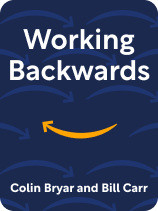

This article is an excerpt from the Shortform book guide to "Working Backwards" by Colin Bryar and Bill Carr. Shortform has the world's best summaries and analyses of books you should be reading.
Like this article? Sign up for a free trial here.
What explains how Amazon became successful? What did the company do differently?
Amazon became successful by creating a strong business culture based on giving value to the customer before all else. If you take a close look at Amazon’s guiding principles and strategies, you’ll see that many of its tools can be used in other businesses too.
Continue reading to see how Amazon grew from a startup into the successful business it is today.
How Amazon Established a Culture of Success
To understand how Amazon became successful, let’s compare it with other businesses. Amazon is more successful than other, more traditional businesses because they consistently do things differently than traditional business wisdom would dictate. Consistently doing things differently is more difficult than it sounds. As a company grows, it becomes impossible for one leader to directly ensure that workers throughout the organization persistently follow an unconventional path to success.
Amazon solved this problem once the company began to scale up: First, managers wrote a list of guiding principles that embodied everything effective about their unique organization. These are rules of thumb intended to shape employee behavior at every level of the company.
Then, Amazon managers designed their internal business practices so employees would act in line with those guiding principles. In other words, they provided workers with models for how to do their jobs that required them to follow the company’s principles. Any company can use this process to establish a productive company-wide culture.
| Building Your Culture Around Virtues and Rules In What You Do Is Who You Are, Ben Horowitz delves into greater detail about how leaders can establish and scale an organizational culture. Horowitz agrees that companies can find outsized success by establishing a culture that’s vastly different from the industry standard. Further, he notes that doing so can powerfully impact the world beyond your organization. If your unorthodox culture proves to be successful, other organizations will mimic it, potentially making your culture the new industry standard. Horowitz offers slightly different advice for leaders who want to continue shaping their organization’s culture as it grows. He refers to the guiding principles a leader must establish as virtues, modeling them after the honor code of the Japanese samurai. Unlike Bryar and Carr, he emphasizes that those virtues should be meaningful and valuable beyond the success or failure of your business. If your company went out of business tomorrow, you’d still be proud that your employees embodied those virtues. Such noble virtues could include personal accountability, social responsibility, or the willingness to collaborate. Horowitz offers an arguably simpler solution for reinforcing these virtues than redesigning your business practices from the ground up: Just set rules that directly mandate employees to apply the company’s virtues. This way, you don’t need to do the hard work of engineering perfect instructions—you can let employees find their ideal business practices within the constraints of your rules. For example, if you want to center your company around the virtue of “willingness to collaborate,” you can make it a rule that only teams—not individuals—can receive praise or rewards for the success of a project. |
Amazon’s Primary Guiding Principle
What specific principles does Amazon use to remain such a success? Amazon’s foremost guiding principle is that providing a valuable, satisfying customer experience is the company’s top priority. Amazon’s success is largely due to founder Jeff Bezos’s insistence that the surest way to maximize revenue is to provide the most value to customers in the long term.
In practice, Amazon employees apply this guiding principle by working backwards—first, they identify the valuable experience they want to provide to customers. Then, they seek out the resources and skills they need to provide that experience and develop a strategy to create that experience.
In contrast, many traditional companies work forwards: They take stock of the skills and resources they have at their disposal, then choose to pursue business opportunities that they’re already prepared for. In other words, they provide customers with experiences that are easier for them to provide rather than experiences that customers want but don’t yet have. Companies that work forwards have little reason to grow or innovate, limiting their potential value to the customer.
| Working Backwards on a Business Budget “Working backwards” doesn’t mean sketching out your entire production process in reverse. For instance, after they envisioned the Kindle user experience, Amazon employees didn’t work backwards step by step (choosing what distributors would sell their product, then choosing what manufacturers to use, then designing the internal hardware). Perhaps a more intuitive way to frame the idea of working backwards is: Start by deciding what you need most and are unwilling to compromise on. Amazon approaches every business decision by deciding that they’re unwilling to compromise on the customer experience. In contrast, traditional companies (often by default) choose their current skills and resources as the factor they’re unwilling to change or compromise on, curbing their potential growth. Thus, another way to characterize “working forwards” would be misplaced priorities. If a company starts by envisioning an end product but chooses to pursue a lower-quality design because it’s easier in the short term, they’re still working forwards. You can apply this logic not just to product development but also to many other tasks involved in running a business. In Profit First, Mike Michalowicz provides an example of how to do so when budgeting your business. He explains that many traditional companies choose high spending as the factor they’re unwilling to compromise on. That is, they want to spend as much money as they can to expand their business as quickly as possible, believing that this strategy will yield greater profits much more quickly. However, this strategy leaves them vulnerable—if revenue slows, the business’s expenses might greatly outweigh their revenue, putting them out of business. Instead, Michalowicz recommends choosing steady profits as the factor you’re unwilling to sacrifice. Decide how much money you want to save, and only spend as much revenue as you have left over. Your growth will be slower, but your business will incur significantly less financial risk. |
Exercise: Compare Your Organization to Amazon
Consider how your organization compares to Amazon with these thought exercises:
- First, think about what Amazon does better than your organization: Which of their tools would have the greatest positive impact on your organization if implemented, and why? Describe how different your organization would look after implementing this tool.
- What parts in your organization work better than these tools? What could you do to better utilize or improve those strengths? (For example, maybe workers at your company are unusually familiar, trusting, and collaborative. You could leverage this strength by giving subordinates more authority to start collaborative projects.)
- What aspect of your organization most closely resembles Amazon? How could you tweak that part of your organization to be even better?

———End of Preview———
Like what you just read? Read the rest of the world's best book summary and analysis of Colin Bryar and Bill Carr's "Working Backwards" at Shortform.
Here's what you'll find in our full Working Backwards summary:
- How any company can grow the same way Amazon did
- How Amazon rapidly scaled its startup into an online empire
- The four tools Amazon’s workers use for strategy development






